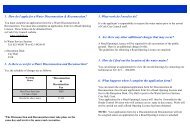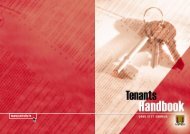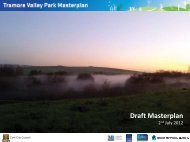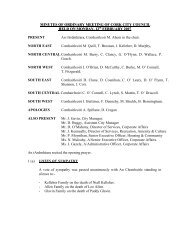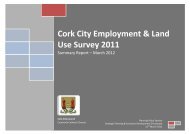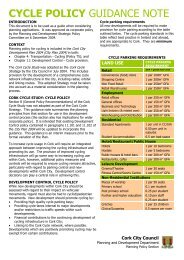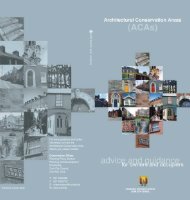Untitled - Cork City Council
Untitled - Cork City Council
Untitled - Cork City Council
You also want an ePaper? Increase the reach of your titles
YUMPU automatically turns print PDFs into web optimized ePapers that Google loves.
<strong>Cork</strong> Strategic Retail Study<br />
5 DEMAND ANALYSIS<br />
Introduction<br />
5.1 This Section provides an analysis of retail demand up to 2013 and then to 2020, split<br />
between comparison goods and convenience goods. The starting points are the<br />
market shares of each of the survey zones, previously defined in Section 4 and Figure<br />
4.1, derived from the household survey. These reflect current shopping patterns. We<br />
then apply these market shares to estimates of retail expenditure by residents in the<br />
base year, 2007, giving an expenditure pattern for the five zones of the Study Area and<br />
a total for the whole Study Area.<br />
5.2 Figures for imported expenditure, based on the shopper survey and Bord Failte data,<br />
are then added in to provide estimates of the turnover of each centre or area. These<br />
turnover estimates are tested by deriving sales per square metre for each of the main<br />
centres. The process is then shifted forward to 2013 and 2020 using data on future<br />
population growth and increases in retail expenditure. All prices in this and subsequent<br />
sections are at constant 2004 levels.<br />
Comparison Expenditure Patterns<br />
Base Year Expenditure<br />
5.3 The next table sets out comparison expenditure for each zone in 2007. Populations are<br />
as detailed in Appendix 1. Per-capita expenditure is derived from the RTP retail model,<br />
described in Appendix 4. Multiplying the population of each zone by its average percapita<br />
expenditure gives an estimate of total comparison goods spending in the Study<br />
Area which is shown in Table 5.1. It should be noted that this also includes a small<br />
element of turnover in shops which is generated by retail spending of local businesses<br />
on goods such as office supplies and stationery – Appendix 4 provides the details.<br />
Table 5.1 Expenditure By Residents On Comparison Goods, 2007 (€ million)<br />
<strong>City</strong> and<br />
Douglas<br />
Rest of<br />
Met.<br />
Area<br />
Ring North Far<br />
west<br />
Total %<br />
Comparison<br />
expenditure per<br />
capita 3,268 3,489 3,183 2,956 3,052<br />
Population 2007 139,454 139,335 106,991 45,533 57,914 489,227<br />
Total comparison<br />
expenditure (€ mill) 455.7 486.2 340.6 134.6 176.7 1,593.8 100.0<br />
Total RWH<br />
expenditure (€ mill) 68.4 80.2 41.5 23.8 9.1 222.9 14.0<br />
Pure comparison<br />
expenditure (€ mill) 387.3 406.0 299.1 110.8 167.6 1,370.9 86.0<br />
Note: market shares are rounded; the total does not add to 100 due to this rounding.<br />
5.4 Total comparison expenditure ranges from over €450 million in each of the two inner<br />
zones down to €135 million in the North zone. Total expenditure for the entire Study<br />
Area is €1,594 million<br />
5.5 The market shares shown in the previous section apply to “pure” comparison goods<br />
only (i.e. high street type shopping, but not retail warehouses) so it is necessary to<br />
deduct an estimate for comparison goods expenditure in retail warehouses. In 2007<br />
the Study Area had around 89,000 sq m of retail warehousing which, at an average<br />
Roger Tym & Partners with Simon Clear & Associates<br />
March 2008 31



